
Core NFT Assetを作成する方法
こちらは、Metaplexの「MPL Coreプロトコル」を使用して、Solanaブロックチェーン上に次世代のデジタルアセットNFT(Core Asset)を作成するガイドです。MPL Core Assetsは、シンプルな設計と独自のプラグインシステムにより、クリエイターと所有者の両方にとって、より大きな創造性と幅広いダイナミックな体験を提供し、Solana上の次世代NFTプロジェクトの波を生み出します。
前提条件
お好みのコードエディタ(Visual Studio Codeを推奨)
Node 18.x.x以上
初期セットアップ
このガイドでは、単一のファイルスクリプトに基づいてJavaScriptを使用し、NFT Core Assetの作成を行います。必要に応じて、関数の修正や移動が必要になる場合があります。
初期化
まず、(任意で)新しいプロジェクトを初期化します。お好みのパッケージマネージャー(npm、yarn、pnpm、bun)を使用し、プロンプトが表示されたら必要な詳細を入力してください。
npm init必要なパッケージ
このガイドで使用する必要なパッケージをインストールします。
@metaplex-foundation/umi
@metaplex-foundation/umi-bundle-defaults
@metaplex-foundation/mpl-core
@metaplex-foundation/umi-uploader-irys
npm i @metaplex-foundation/uminpm i @metaplex-foundation/umi-bundle-defaultsnpm i @metaplex-foundation/mpl-corenpm i @metaplex-foundation/umi-uploader-irys;インポートとラッパー関数
ここでは、このガイド特有の必要なインポートをすべて定義し、コードを実行するためのラッパー関数を作成します。
import { create, mplCore } from '@metaplex-foundation/mpl-core'
import {
createGenericFile,
generateSigner,
signerIdentity,
sol,
} from '@metaplex-foundation/umi'
import { createUmi } from '@metaplex-foundation/umi-bundle-defaults'
import { irysUploader } from '@metaplex-foundation/umi-uploader-irys'
import { base58 } from '@metaplex-foundation/umi/serializers'
import fs from 'fs'
import path from 'path'
// Create the wrapper function
const createNft = async () => {
///
///
/// all our code will go in here
///
///
}
// run the wrapper function
createNft()Umiのセットアップ
この例では「generatedSigner()」を使用してUmiをセットアップする手順を説明します。Reactでこの例を試したい場合は「React - Umi w/ Wallet Adapter」ガイドを参考にUmiをセットアップする必要があります。このガイドでは、ウォレットのセットアップ以外に、fileStorageキーとwallet adapterについても説明します。
新しいウォレットの生成
const umi = createUmi('https://api.devnet.solana.com')
.use(mplCore())
.use(
irysUploader({
// mainnet address: "https://node1.irys.xyz"
// devnet address: "https://devnet.irys.xyz"
address: 'https://devnet.irys.xyz',
})
)
const signer = generateSigner(umi)
umi.use(signerIdentity(signer))
// This will airdrop SOL on devnet only for testing.
console.log('Airdropping 1 SOL to identity')
await umi.rpc.airdrop(umi.identity.publickey)既存のウォレットの使用
const umi = createUmi('https://api.devnet.solana.com')
.use(mplCore())
.use(irysUploader())
// Generate a new keypair signer.
const signer = generateSigner(umi)
// You will need to us fs and navigate the filesystem to
// load the wallet you wish to use via relative pathing.
const walletFile = fs.readFileSync('./keypair.json')
// Convert your walletFile onto a keypair.
let keypair = umi.eddsa.createKeypairFromSecretKey(new Uint8Array(walletFile));
// Load the keypair into umi.
umi.use(keypairIdentity(umiSigner));NFTの作成
画像のアップロード
まず最初に行うべきことは、NFTを表現し、認識可能にする画像をアップロードすることです。これはjpeg、png、またはgif形式で可能です。
Umiには、Arweave、NftStorage、AWS、ShdwDriveなどのストレージソリューションにアップロードできるダウンロード可能なストレージプラグインが付属しています。このガイドの冒頭で「irysUploader()」プラグインをインストールしました。これはArweaveブロックチェーンにコンテンツを保存するものなので、ここではこれを使用します。
💡 ローカルスクリプト/Node.js
この例では、Irysを使用してArweaveにアップロードするローカルスクリプト/Node.jsのアプローチを使用しています。別のストレージプロバイダーにファイルをアップロードしたり、ブラウザからアップロードしたりする場合は、別のアプローチを取る必要があります。「fs」のインポートと使用は、ブラウザ環境では機能しません。
// use `fs` to read file via a string path.
const imageFile = fs.readFileSync('./assets/my-image.jpg')
// Use `createGenericFile` to transform the file into a `GenericFile` type
// that umi can understand. Make sure you set the mimi tag type correctly
// otherwise Arweave will not know how to display your image.
const umiImageFile = createGenericFile(imageFile, 'my-image.jpeg', {
tags: [{ name: 'Content-Type', value: 'image/jpeg' }],
})
// Here we upload the image to Arweave via Irys and we get returned a uri
// address where the file is located. You can log this out but as the
// uploader can takes an array of files it also returns an array of uris.
// To get the uri we want we can call index [0] in the array.
const imageUri = await umi.uploader.upload([umiImageFile]).catch((err) => {
throw new Error(err)
})
console.log(imageUri[0])メタデータのアップロード
有効で機能する画像URIを取得したら、トークンのメタデータの作業に取り掛かることができます。
fungible tokenのオフチェーンメタデータの標準は以下の通りです。
const metadata = {
name: 'My NFT',
description: 'This is an NFT on Solana',
image: imageUri[0],
external_url: 'https://example.com',
attributes: [
{
trait_type: 'trait1',
value: 'value1',
},
{
trait_type: 'trait2',
value: 'value2',
},
],
properties: {
files: [
{
uri: imageUri[0],
type: 'image/jpeg',
},
],
category: 'image',
},
}ここに含まれるフィールドは以下の通りです。
name
トークンの名前。
description
NFTの説明。
image
これは以前アップロードした 「imageUri(または画像のオンラインロケーション)」に設定されます。
animation_url
これはアップロードした 「animation_url(または動画/glbファイルのオンラインロケーション)」に設定されます。
external_url
これは任意の外部アドレスにリンクします。通常はプロジェクトのウェブサイトです。
attributes
{trait_type: "value", "value": "value1"}のようなオブジェクトを使用します。
image
これは以前アップロードした 「imageUri(または画像のオンラインロケーション)」に設定されます。
properties
「files」フィールドを含み、{uri: string, type: mimeType}の [] array を受け取ります。また、「image」「audio」「video」「vfx」「html」 に設定できる category フィールドも含まれます。
// Call upon umi's `uploadJson()` function to upload our metadata to Arweave via Irys.
const metadataUri = await umi.uploader.uploadJson(metadata).catch((err) => {
throw new Error(err)
})すべてが計画通りに進んでいれば、エラーが発生しなかった場合、JSONファイルのURIが metadataUri に保存されているはずです。
Core Asset NFTのミント
ここからは、mpl-core パッケージの create 関数を使用して、Core Asset NFTを作成することができます。
const assetSigner = generateSigner(umi)
const tx = await create(umi, {
asset: nftSigner,
name: 'My NFT',
uri: metadataUri,
}).sendAndConfirm(umi)ログの詳細を出力する
// Log out the signature and the links to the transaction and the NFT.
console.log('\nNFT Created')
console.log('View Transaction on Solana Explorer')
console.log(`https://explorer.solana.com/tx/${signature}?cluster=devnet`)
console.log('\n')
console.log('View NFT on Metaplex Explorer')
console.log(`https://core.metaplex.com/explorer/${nftSigner.publicKey}?env=devnet`)フルコード 例
import { create } from '@metaplex-foundation/mpl-core'
import {
createGenericFile,
generateSigner,
signerIdentity,
sol,
} from '@metaplex-foundation/umi'
import { createUmi } from '@metaplex-foundation/umi-bundle-defaults'
import { base58 } from '@metaplex-foundation/umi/serializers'
import fs from 'fs'
import path from 'path'
const createNft = async () => {
//
// ** Setting Up Umi **
//
const umi = createUmi('https://api.devnet.solana.com')
.use(mplCore())
.use(
irysUploader({
// mainnet address: "https://node1.irys.xyz"
// devnet address: "https://devnet.irys.xyz"
address: 'https://devnet.irys.xyz',
})
)
const signer = generateSigner(umi)
umi.use(signerIdentity(signer))
// Airdrop 1 SOL to the identity
// if you end up with a 429 too many requests error, you may have to use
// the filesystem wallet method or change rpcs.
console.log('Airdropping 1 SOL to identity')
await umi.rpc.airdrop(umi.identity.publicKey, sol(1))
//
// ** Upload an image to Arweave **
//
// use `fs` to read file via a string path.
// You will need to understand the concept of pathing from a computing perspective.
const imageFile = fs.readFileSync(
path.join('./image.png')
)
// Use `createGenericFile` to transform the file into a `GenericFile` type
// that umi can understand. Make sure you set the mimi tag type correctly
// otherwise Arweave will not know how to display your image.
const umiImageFile = createGenericFile(imageFile, 'image.png', {
tags: [{ name: 'Content-Type', value: 'image/png' }],
})
// Here we upload the image to Arweave via Irys and we get returned a uri
// address where the file is located. You can log this out but as the
// uploader can takes an array of files it also returns an array of uris.
// To get the uri we want we can call index [0] in the array.
console.log('Uploading Image...')
const imageUri = await umi.uploader.upload([umiImageFile]).catch((err) => {
throw new Error(err)
})
console.log('imageUri: ' + imageUri[0])
//
// ** Upload Metadata to Arweave **
//
const metadata = {
name: 'My NFT',
description: 'This is an NFT on Solana',
image: imageUri[0],
external_url: 'https://example.com',
attributes: [
{
trait_type: 'trait1',
value: 'value1',
},
{
trait_type: 'trait2',
value: 'value2',
},
],
properties: {
files: [
{
uri: imageUri[0],
type: 'image/jpeg',
},
],
category: 'image',
},
}
// Call upon umi's `uploadJson` function to upload our metadata to Arweave via Irys.
console.log('Uploading Metadata...')
const metadataUri = await umi.uploader.uploadJson(metadata).catch((err) => {
throw new Error(err)
})
//
// ** Creating the NFT **
//
// We generate a signer for the NFT
const nftSigner = generateSigner(umi)
console.log('Creating NFT...')
const tx = await create(umi, {
asset: nftSigner,
name: 'My NFT',
uri: metadataUri,
}).sendAndConfirm(umi)
// Finally we can deserialize the signature that we can check on chain.
const signature = base58.deserialize(tx.signature)[0]
// Log out the signature and the links to the transaction and the NFT.
console.log('\nNFT Created')
console.log('View Transaction on Solana Explorer')
console.log(`https://explorer.solana.com/tx/${signature}?cluster=devnet`)
console.log('\n')
console.log('View NFT on Metaplex Explorer')
console.log(`https://core.metaplex.com/explorer/${nftSigner.publicKey}?env=devnet`)
}
createNft()